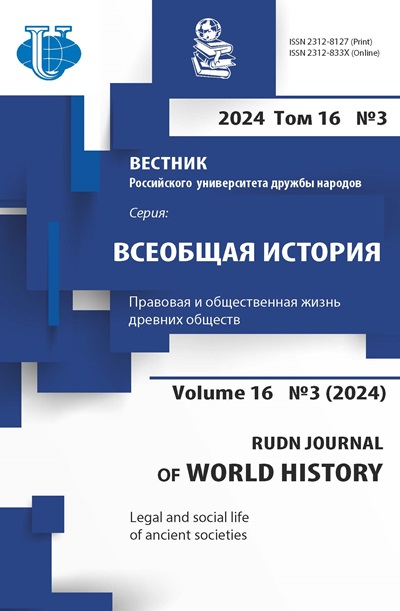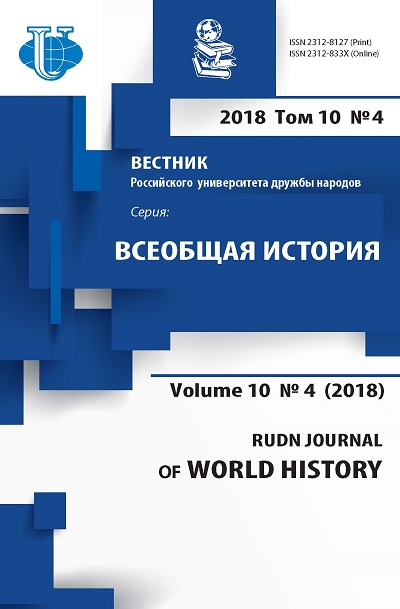Vol 10, No 4 (2018)
- Year: 2018
- Articles: 7
- URL: https://journals.rudn.ru/world-history/issue/view/1168
- DOI: https://doi.org/10.22363/2312-8127-2018-10-4
Full Issue
Oriental Studies
Caliphatism in the period of decline and collapse of the Ottoman Empire
Abstract
The article analyses the historical role of the movement for defenсe of the Caliphate, which emerged in various regions of the Muslim world as a response to weakening and fall of the Ottoman Empire. The authors also focus on the social and political discussions of the 1920s - 1930s about the destiny of Muslim unity and the role of the future Caliphate. The article also deals with the transformation of conceptions of the Caliphate in the works of eminent ideologists and politicians of the Muslim world - Jamal al-Din al-Afghani, Abd al-Rahman al-Kawakibi, Muhammad Rashid Rida and Abul Kalam Azad. The authors give an overview of the history of Caliphatist congresses and conferences of 1920s - 1930s. The aims and tasks of the Caliphatist movement among the Muslims of South Asia are also under study. The article examines the reaction of the South Asian princely elites to the weakening of the Ottoman state and explores the interrelation between pro-Ottoman sentiments of Caliphatists and the radicalization of anti-colonial struggle of Indian Muslims. A special attention is given to the role of leaders of Indian Caliphatists in preparation of the antiBritish uprisings in North-Western Hindustan. The authors also examine common and specifi c features of views and political actions of advocates and supporters of the Caliphate in the Middle East and in the Islamic communities of South Asia. The analysis of the source data reveales several patterns of reaction of Muslims in the Middle East, North Africa and South Asia to the repudiation of the Caliphate by the Republican Turkey.
 327-337
327-337


Beirut under Russian rule Part 1. The eve of the occupation (1772-1773)
Abstract
During the Russian-Ottoman war of 1768-1774 Russia became the fi rst European country that invaded Middle East in the Modern times and even for the short period occupied its part: the town of Beirut. The events that preceded the assault and capture of the town were fi xed by the local chroniclers and Russian offi cers; as well they were refl ected in the messages of Arab rulers and the reports of the diplomats residing in Syria. As a result the volumetric picture of the society is emerging that for the first time faced the colonial expansion of the modernized Europe. The fi rst part of presented article is devoted to the analysis of the socio-political situation in the region on the eve of the arrival of the Russian squadron at the Syrian coast. Special attention is paid to the situation in Beirut before and during the fi rst assault of the town in June 1772, and to the subsequent change in the balance of power in Lebanon.
 338-354
338-354


Models of Egypt’s self-identifi cation in the interwar period (1919-1939)
Abstract
In the article, the authors consider the models of self-identification typical for the public thought of Egypt of the interwar period. In the fi rst half of XX century Egypt entered an important period of its history. As one of the fi rst formally independent Arab States, Egypt continued to struggle for full sovereignty from the United Kingdom while seeking to establish itself as a regional leader. In this regard, the leading thinkers of Egypt tried to determine the place of their country in the world and fi nd the most acceptable ideology for it, which could also rally other Arab, Muslim, Asian and African countries around Egypt. The article touched upon four concepts that were developed during the interwar period and infl uenced the further development of public thought in Egypt. Some thinkers have tried to develop a model of secular pan-Arabism based on the ideas of al-Kawakibi and al-Husri. For these authors, Egypt was an integral part of the Arab world and the core of its possible unifi cation. The second concept was related to pan-Islamism: developing the ideas of al-Afghani, the ideologues of this direction interpreted Egypt primarily as a Muslim country and part of the Dar al-Islam . For example, “Muslim Brotherhood” belonged to this group. The third concept is associated with the comprehension of the identity of Egypt through the idea of “pharaonism” and “ tamsir ” modern Egyptians declared heirs of the ancient Egyptian civilization. The fourth concept, conventionally named Eastern Idea or Easternism , was founded on the opposition of all the countries of the East to Western countries. Each of the areas of identity of Egypt - pan-Arab, pan-Islamic, Egyptian (“pharaonism”) and Easternism - made a contribution to the development of the identity of Egyptian society in the interwar period, and somehow infl uenced on the history of Egypt in the second half of the XX century.
 355-370
355-370


Rand rebellion of 1922: the perception in British public opinion
Abstract
The article presents the research of the problem of white miners uprising in Witwatersrand in January-March 1922. The aim of the research was to surround the causes of the uprising, the reaction of British establishment and press, as well as the leader of the South African Union. Based on a number of sources, are shown the history of the issue and the driving forces of the rebels. The article contains an indication of both the traditional factors of the strike, characteristic of the industry of the fi rst half of XX, and the specifi c features of South Africa that aff ected the uprising. The author paid attention to the way of analyzing by the British press the causes of the uprising, and how various publications appreciate it, depending on their ideology. Besides, is considered the signifi cance of the uprising for further decision-making by the British leadership on colonial policy.
 371-381
371-381


“One belt, one road” initiative as a new cooperation model of the PRC with Russia and Central Asia countries
Abstract
The Silk Road Economic Belt and 21st Century Maritime Silk Route established China’s new external strategy basis for the near-term historical perspective. The implementation of these projects, which were united under the common name “One belt, one road”, will become one of the most important tasks of Beijing to optimize the spatial structure of the entire Eurasian region economic development. Russia and Central Asian countries take a prominent place in the process of implementing this initiative. China actively cooperates with these countries. All parties receive great benefi ts of this comprehensive cooperation. The purpose of this article is to determine the role of Russia and Central Asian countries in the implementation of the Chinese initiative “One belt, one road”. In accordance with the purpose, the following tasks were set: to study the main types and directions of China’s cooperation with Russia and the Central Asian republics within the framework of the initiative, to analyze the specifi cs of this cooperation, and to consider the aspects of interaction between the parties. The problem-chronological approach was used as a methodological basis, it allows to study certain aspects of interaction, international relations subjects. Based on the results of the analysis, the author concludes that Russia and the Central Asian republics take a key place in the implementation of the Chinese initiative “One belt, one road”.
 382-392
382-392


Characteristics of Chinese economy in 2000-2016: economic growth sustainability
Abstract
The aim of the research is to determine through the historical perspective the reasons of China’s economic slowdown in 2000-2016 and using historical data to fi nd out whether it is possible to return to the high rates of economic growth or at least to sustain the current GDP growth rates in between 6-7%. The hypothesis is that China is unable to return to the doubledigit economic growth rates or even to sustain the current GDP growth rates in the long or shortterm. The hypothesis will be proved through mixed methodology with the implementation of descriptive and historical research designs, which involve collection, verifi cation, and synthesis of evidence from the period since 2000-s and up to the present moment.
 393-402
393-402


Antique world
Great Panathenaia in Greek drama
Abstract
The works of the Greek playwrights of the classical period are an interesting source on the history of the panatheniac festival. The tragedies of Aeschylus, Sophocles, Euripides, and the comedies of Aristophanes contain information about both the sacred part of the Great Panathenaia and agones the Panathenaic games. Of the elements of the sacral part of the Panathenaic festival were most often mentioned holiday peplos for Athena, the participants of the Panathenaic procession, the night procession, sacrifi ce. Part of the Panathenaic games were both in agony, which is characteristic for the Panhellenic games available for the citizens of Greece and local competitions, participation in which was limited only to the citizens of Athens. The mention of agones inherent in the Panhellenic games can be found in many works of Greek playwrights, but nowhere is there a clarifi cation that we are talking about the Panathenaic games. But it is interesting to note that more mentioned in the tragedies, and especially in the comedies of Aristophanes local competitions, which were sacred.
 403-414
403-414
















